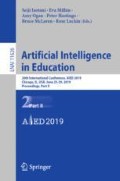Abstract
Personalization of online courses is one of the challenges of the 21st century. Although different methodologies for personalization in educational contexts are already existing, there is a bottleneck: personalization by context is always limited to existing learning material; creation of those is a time-consuming task. In this paper we introduce a pipeline to generate questions and valid answers based on educational texts, limited to factual questions for given sentences. We combined NLP technologies with an efficient methodology that is normally used in bioinformatics and adjusted it to generate Q&A-pairs. Instructors can suggest corrections in natural language. Our system generates questions and corresponding answers based on sentences of which 70% make sense.
Access this chapter
Tax calculation will be finalised at checkout
Purchases are for personal use only
References
National Academy of Sciences: Advance personalized learning NAE Grand Challenges for Engineering, Updated 2017, pp. 45–47 (2008)
Bloom, B.: Bloom’s Taxonomy of Educational Objectives, Vol. 1: Cognitive Domain, New York, McKay (1965)
Heilman, M., Smith, N.A.: Question generation via overgenerating transformations and ranking. Pittsburgh, Language Technologies Institute (2009)
Heilman, M., Smith, N.A.: Good question! Statistical ranking for question generation. In: The 2010 Annual Conference of the North American Chapter of the Association for Computational Linguistics, Los Angeles, California, HLT 2010, pp. 609–617 (2010)
Le, N.-T., Shabas, A., McLaren, P.: QUESGEN: a framework for automatic question generation using semantic web and lexical databases. In: Spector, J.M., et al. (eds.) Frontiers of Cyberlearning. LNET, pp. 69–89. Springer, Singapore (2018). https://doi.org/10.1007/978-981-13-0650-1_4
Le, N.-T., Shabas, A., Pinkwart, N.: A question generation framework for teachers. In: Penstein Rosé, C., et al. (eds.) AIED 2018. LNCS (LNAI), vol. 10948, pp. 182–186. Springer, Cham (2018). https://doi.org/10.1007/978-3-319-93846-2_33
Zhao, S., Wang, H., Li, C., Liu, T., Guan, Y.: Automatically generating questions from queries for community-based question answering. In: Proceedings of the 5th International Joint Conference on Natural Language Processing, Chiang Mai, Thailand, AFNLP, pp. 929–937 (2011)
Rodrigues, H.P., Coheur, L., Nyberg, E.: QGASP: a framework for question generation based on different levels of linguistic information. In: Proceedings of the 9th International Natural Language Generation conference, Edinburgh, UK, pp. 242–243. Association for Computational Linguistic (2016)
Rajpurkar, P., Jian Zhang, K.L., Liang, P.: SQuAD: 100,000+ questions for machine comprehension of text. In: Conference on Empirical Methods in Natural Language Processing (2016)
Altschul, S.F., Erickson, B.W.: Optimal sequence alignment using affine gap costs. Bull. Math. Biol. 48, 603–616 (1986)
LM Digital Media: General Knowledge Quiz for kids to Intrigue their Senses, 11 October 2017. kidsworldfun.com. Accessed 01 Feb 2018
Fellbaum, C.: WordNet. In: Chapelle, C. (ed.) The Encyclopedia of Applied Linguistics. Blackwell Publishing Ltd., Chichester (2012)
Karamanis, N., Ha, L.A., Mitkov, R.: Generating multiple-choice test items from medical text: a pilot study. In: Proceedings of the Fourth International Natural Language Generation Conference, Sydney, pp. 111–113. Association for Computational Linguistics (2006)
Acknowledgments
This work was supported by the German Federal Ministry of Education and Research (BMBF), grant number 16DII116 (Weizenbaum-Institute). The responsibility for the content of this publication remains with the authors.
Author information
Authors and Affiliations
Corresponding author
Editor information
Editors and Affiliations
Rights and permissions
Copyright information
© 2019 Springer Nature Switzerland AG
About this paper
Cite this paper
Rüdian, S., Pinkwart, N. (2019). Towards an Automatic Q&A Generation for Online Courses - A Pipeline Based Approach. In: Isotani, S., Millán, E., Ogan, A., Hastings, P., McLaren, B., Luckin, R. (eds) Artificial Intelligence in Education. AIED 2019. Lecture Notes in Computer Science(), vol 11626. Springer, Cham. https://doi.org/10.1007/978-3-030-23207-8_44
Download citation
DOI: https://doi.org/10.1007/978-3-030-23207-8_44
Published:
Publisher Name: Springer, Cham
Print ISBN: 978-3-030-23206-1
Online ISBN: 978-3-030-23207-8
eBook Packages: Computer ScienceComputer Science (R0)

